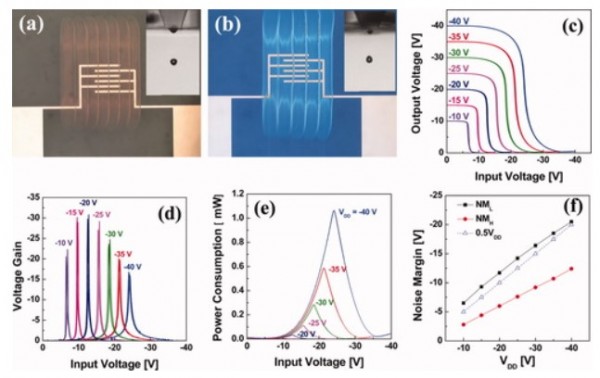High speeds complementary integrated circuits fabricated with all-printed polymeric semiconductors
- 저자
- Kang-Jun Baeg, Dongyoon Khim, Dong-Yu Kim*, Soon-Won Jung, Jae Bon Koo, In-Kyu You, Henry Yan, Antonio Facchetti* and Yong-Young Noh*
- 저널명
- Journal of Polymer Science: Part B: Polymer Physics, 49, 1, 62-67 (2011)
- 년도
- 2011
- Link
- http://dx.doi.org/10.1002/polb.22148 448회 연결
[Abstract]
Inkjet-printed high speed polymeric complementary circuits are fabricated using an n-type ([poly{[N,N′-bis(2-octyldodecyl)-naphthalene-1,4,5,8-bis(dicarboximide)-2,6-diyl]-alt-5,5′-(2,2′-dithiophene)} [P(NDI2OD-T2), Polyera ActivInk N2200] and two p-type polymers [poly(3-hexylthiophene) (P3HT) and a dithiophene-based polymer (Polyera ActivInk P2100)]. The top-gate/bottom-contact (TG/BC) organic field-effect transistors (OFETs) exhibit well-balanced and very-high hole and electron mobilities (μFET) of 0.2–0.5 cm2/Vs, which were enabled by optimization of the inkjet-printed active features, small contact resistance both of electron and hole injections, and effective control over gate dielectrics and its orthogonal solvent effect (selection of poly(methyl methacrylate) and 2-ethoxyethanol). Our first demonstrated inkjet-printed polymeric complementary devices have been integrated to high-performance complementary inverters (gain >30) and ring oscillators (oscillation frequency ∼50 kHz). We believe that the operating frequency of printable organic circuits can be further improved more than 10 MHz by fine-tuning of the device architecture and optimization of the p- and n-channel semiconductor processing.
